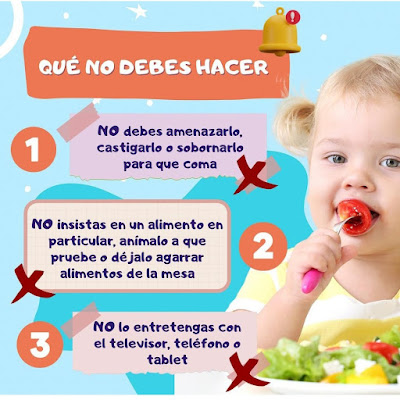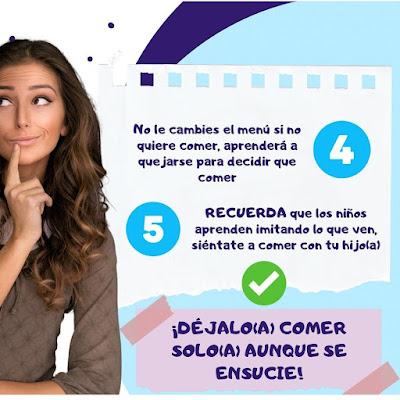Cómo Estimular el apetito en los Niños
Tips to increase the appetite in Children
EDITORIAL ESPAÑOL
==================
La alimentación en los niños es un punto muy importante para un
buen crecimiento y desarrollo del niño, y para ello los padres
debe jugar un rol importante. Si notas que tu niño "no quiere
comer" o rechaza algún alimento, aquí te dejo varios consejos que
te ayudarán a estimular el apetito en tu niño y comer alimentos
variados:
1.) Lo primero que debes saber: El 50% de los niños entre los
18 y 23 meses atraviesa por esta etapa. Entonces aquí es donde hay que aplicar sutiles estrategias, que
harán que el niño acepte nuevos alimentos y aumente su apetito,
tips que deben realizarse inteligentemente y que al ser aplicados
obtendrás el resultado deseado.
SITUACIONES QUE NO DEBES HACER:
1.) Lo primero, no amenazarlo si no come determinado
alimento, tampoco castigarlo o sobornarlo. Estos 3
eventos lo que provocarán es mayor rechazo del niño a un
determinado alimento e incluso a rechazar la alimentación como
tal.
2.) NO INSISTIR en un aliento en particular: Si
te empeñas en que coma determinado alimento lo que lograras
es que se genere la respuesta contraria, es decir, rechazo o
desprecio a ese alimento en particular, animalo a que pruebe
SIN PRESIONES, o que por si mismo agarre los alimentos que
están en la mesa.
3.) EVITA excederte en la cantidad de LÁCTEOS y derivados
que le da durante el dia: rSi entre las comidas le das LÁCTEOS, y otros alimentos,
que en muchos casos son "chucherías" estarás logrando una
disminución del apetito del niño, el cual se sentirá más
"lleno" a la hora de comer, y por lo tanto la calidad de la
alimentación buena y variada no será la
adecuada.
Aquí hay que resaltar los "chuches" o "chucherías" muy de
moda hoy en dia; chocolates, chiclets, doritos, pringles,
gomitas, caramelos, etc. Evitarlos es casi imposible, pero
abusar de ello además de generar cuadros alérgicos
respiratorios (rinitis, sinusitis) y de piel (dermatitis
atópica), PROVOCARÁN una dependencia hacia ellos y a la hora
de comer tendrás el mismo problema.
4.) Darles su tiempo para comer, NO LO
APURES: Todo a su tiempo, no hay que apurarle ni
forzarlo, en la medida que pase el tiempo el niño
ira "tomando el ritmo", porque es una cuestión de
hábito, una vez creado, a la hora de comer y
alimentación no tendrás problemas.
5.) Si NO lograste que comiera: NO le
ofrezcas alimentos hasta la próxima comida, y si
los demanda NO le des "chuches", porque estaras
creando un círculo vicioso, tampoco lo regañes
si no comió, porque puedes estar creando una
conducta de rechazo hacia la alimentación.
SITUACIONES QUE SI DEBES HACER
1.) Explicarle que su cuerpo necesita
alimentarse para crecer: Utilizando un lenguaje entendible para su
edad, decirle al niño que lo alimentos no
solo son necesarios para crecer, sino que
también son fuente de energía para jugar,
hacer deportes, y fuente de salud y
resistencia contra las enfermedades.
2.) Estrategia de la poca comida en
el plato: Es preferible que el plato de
comida no esté "tan abundante",
esto probablemente provocará que pida
más alimentos SI LO DESEA, la comida
entra por los "ojos" dice un refrán, si
ve el plato medio vacío o no completo
probablemente pedirá mas.
3.) Presentar el plato de forma
divertida y variada: Hay que cortar con la
rutina de lo habitual, es decir
presentar siempre el mismo plato,
es decir hacer platos divertidos y
coloridos que llamen la atención y
dejar que el niño elija por sí
mismo los alimentos que están en
la mesa para toda la
familia.
4.) No lo cambies el menú si NO quiere comer: Esta estrategia provocará
que se queje y decida o pida que
alimentos quiere comer, de los
que ya ha probado, cual le
gusta más, y eso te dará
una pauta importante, porque
entre gustos hay mucha variedad.
Poco a poco iras aprendiendo
cuáles son sus alimentos
preferidos y esto te servirá
para ir incluyendo nuevos.
5.) Los niños aprenden
IMITANDO lo que
ven:
Siéntate a comer con
tus niños, la comida en
familia es un
elemento importante, un
gran estímulo para
ellos, pues
estarán viendo los
alimentos que comes,
y de paso
enseñado indirectamente
las buenas costumbres a la
hora de sentarse a comer,
los buenos
modales.
Otros
consejos:
- Ser paciente y
persistente: si el niño
no quiere comer o come
poco, hay que tener
paciencia y seguir
insistiendo de manera
pausada y agradable. NO
DESESPERAR.
- Comer los mismos
alimentos que se le
ofrecerán al niño: aquí
la estrategia de la
IMITACIÓN funcionara
perfectamente.
- Involucrar al niño en
la preparación de la
comida: esto generara un
mayor interés del niño
en los alimentos y en
probarlos.
Independientemente de
haber aplicado
AMOROSAMENTE todas estas
estrategias y notas que
tu niño está bajo de
peso e inapetente, debes
buscar asistencia médica
con tu pediatra para que
te oriente y averiguar
si hay una causa
subyacente que está
ocasionando ello.
EDITORIAL
ENGLISH
==================
Nutrition in
children is a
very important
point for good
growth and
development of
the child, and
for this parents
must play an
important role.
If you notice
that your child
"does not want
to eat" or
refuses some
food, here are
several tips
that will help
you stimulate
your child's
appetite and eat
a variety of
foods:
1.) The first
thing you
should know:
50% of
children between
18 and 23 months
go through this
stage. So this
is where you
have to apply
subtle
strategies that
will make the
child accept new
foods and
increase their
appetite, tips
that must be
done
intelligently
and that when
applied you will
obtain the
desired result.
SITUATIONS
YOU SHOULD NOT
DO:
1.) First of
all, do not
threaten him
if he does not
eat a certain
food, nor punish
him or bribe
him. What these
3 events will
cause is greater
rejection by the
child of a
certain food and
even rejecting
the food as
such.
2.) DO NOT
INSIST on a
particular
food: If you insist
on him eating a
certain food,
what you will
achieve is that
the opposite
response will be
generated, that
is, rejection or
contempt for
that particular
food, encourage
him to try
WITHOUT
PRESSURE, or
that he himself
grabs the food
that is on the
table.
3.) AVOID
exceeding the
amount of
DAIRY and
derivatives
that you give
him during
the day: rIf
between meals
you give him
DAIRY, and other
foods, which in
many cases are
"candies", you
will be
achieving a
decrease in the
child's
appetite, which
You will feel
more "full" at
mealtime, and
therefore the
quality of good
and varied food
will not be
adequate.
Here we must
highlight the
"candies" or
"knick knacks"
that are very
fashionable
today;
chocolates,
chiclets,
doritos,
pringles,
gummies,
candies, etc.
Avoiding them is
almost
impossible, but
abusing them, in
addition to
generating
allergic
respiratory
symptoms
(rhinitis,
sinusitis) and
skin conditions
(atopic
dermatitis),
WILL cause a
dependency on
them and when it
comes to eating
you will have
the same
problem.
4.) Give them
their time to
eat, DON'T
RUSH THEM: Everything
in its time,
there is no need
to rush or force
it, as time goes
by the child
will "pick up
the pace",
because it is a
matter of habit,
once created,
when it comes to
eating and
feeding you will
not have
problems.
5.) If you
DID NOT get
him to eat: DO NOT
offer him food
until the next
meal, and if he
demands it DO
NOT give him
"candy", because
you will be
creating a
vicious circle,
nor do you scold
him if he did
not eat, because
you may be
creating a
behavior of
rejection of
food.
SITUATIONS
THAT YOU
SHOULD DO
1.) Explain
that their
body needs
food to
grow: Using
language that is
understandable
for their age,
tell the child
that food is not
only necessary
for growth, but
is also a source
of energy for
playing, playing
sports, and a
source of
health. and
resistance
against
diseases.
2.) Strategy
of little food
on the
plate: It is
preferable that
the plate of
food is not "so
abundant", this
will probably
cause you to ask
for more food IF
YOU WANT, the
food enters
through the
"eyes" as a
saying goes, yes
Sees the plate
half empty or
not full, he
will probably
order more.
3.) Present
the dish in a
fun and varied
way: You have to cut
the usual
routine, that
is, always
present the same
dish, that is,
make fun and
colorful dishes
that attract
attention and
let the child
choose for
himself the
foods that are
on the table for
the whole
family.
4.) Do not
change the
menu if he
does NOT want
to eat: This
strategy will
cause him to
complain and
decide or ask
for which foods
he wants to eat,
which he has
already tried,
which one he
likes the most,
and that will
give you an
important
guideline,
because between
tastes there is
a lot of
variety. Little
by little you
will learn what
their favorite
foods are and
this will help
you to include
new ones.
5.) Children
learn by
imitating what
they see:
Sit down to eat
with your
children, family
food is an
important
element, a great
stimulus for
them, because
they will be
seeing the food
you eat, and
indirectly
taught good
customs when
sitting down to
eat, good
manners.
Other tips:
- Be patient
and
persistent: if the
child does not
want to eat or
eats little, you
have to be
patient and
continue
insisting in a
slow and
pleasant way.
DON'T DESPERATE.
- Eat the
same foods
that will be
offered to the
child: here the
IMITATION
strategy will
work perfectly.
- Involve the
child in the
preparation of
food: this will
generate greater
interest in the
child in food
and in trying
it.
Regardless of
having LOVINGLY
applied all of
these
strategies and you
notice that your
child is
underweight and
has no appetite,
you should seek
medical
assistance from
your
pediatrician to
guide you and
find out if
there is an
underlying cause
that is causing
this.


















